Content Optimization Tools and Software
Search engine optimization isn’t as easy as it used to be, but technology has evolved to meet the demands of marketers who need a scalable content strategy that reliably produces high-ranking posts.
Here, we’ll explain what content optimization software is (and isn’t), how it can benefit different types of content marketers, where it fits into your workflow, and some of the most popular platforms currently on the market. If you’re ready to start thinking big with your SEO and content strategy, read on.
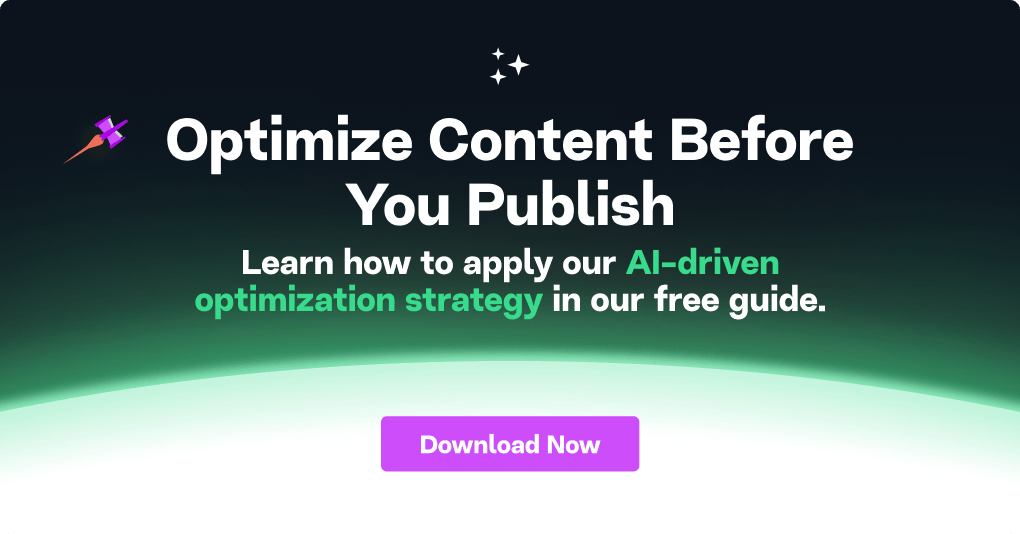
What is Content Optimization Software?
Content optimization software is a solution that supports a full-scale SEO and content strategy, from conception to results measurement. MarketMuse, for instance, is a machine learning platform that provides insights on which topics and subtopics you need to cover with your content to gain authority in your industry. The software uses two patented topic models to automate recommendations on what you should be writing, and how to write it.
Additionally, all subscriptions include help desk support. Depending on your subscription level, you may also have access to an onboarding specialist, customer success manager, strategic planning, and a content strategist consultant.
MarketMuse was built as a direct response to the Google Hummingbird algorithm, which gives the search engine semantic analysis capability. This change, which occurred in 2013, shifted SEOs’ focus from keywords to writing quality content. Now, we know that Google uses topic modeling to rank content based on relevancy to a query, so the focus has again shifted to user intent and topical authority.
Bottom line: If your content isn’t answering user intent, it’s not going to rank in SERPs. Content optimization software sheds light on what it means to cover a topic comprehensively by producing a list of related topics. It can also point to gaps in your existing content so you can update it for topical authority.
In optimizing content for user intent, the platform also assists conversion rate optimization efforts by allowing you to create content that qualifies visitors and brings them through the customer journey.
It’s difficult to replicate the results of content optimization software (if it weren’t, there wouldn’t be a market for it) so a truly robust system won’t just enhance your content creation process, it should revolutionize the way you think about your SEO strategy and give you a clear competitive edge. Think of it as a whole new member of your content creation team.
Where Does Content Optimization Software Fit into an Existing Workflow?
Using MarketMuse or another platform requires a tweak in your process, not an overhaul. Each client’s content creation workflow will differ, depending on your team and volume of work. Here’s an example of a typical process:
- Decide what content needs optimization.
- Determine how best to optimize.
- Create a content brief or outline.
- Write an optimized draft.
- Publish the content.
- Measure the results.
To realize maximum benefit, content optimization can’t be a stand-alone task. It needs to be integrated across the entire process from start to finish.
Topic Modeling Drives Successful Content Optimization
Content optimization success is the result of comprehensive topical coverage. That achievement is predicated on the ability to address the right related topics.
Content optimization software does this through topic modeling. Yet not all topic models are equal.
Here are a few questions to ask.
How large is the corpus used for topic modeling?
A corpus is a collection of documents used to create the topic model. Robust topic models use a large corpus, but most content optimization tools take shortcuts.
If the topic model is restricted to analyzing the top 10, 20 or 30, search results, you’ll miss out on opportunities to differentiate your content.
How are they modeling topics?
MarketMuse uses its own patented method, analyzing thousands of documents to create a topic model. As a result, it can surface topics that other optimization tools miss.
Other tools rely on third-party data accessed through an application programming interface (API) to create their topic models. Consequently, their ability is limited to what their provider offers.
Are their suggestions based on TF-IDF or LSI keywords?
At the bottom of the topic modeling hierarchy are tools that use term frequency inverse document frequency (TF-IDF) or that provide latent semantic keywords. TF-IDF cannot perform topic modeling and it’s unlikely Google uses TF-IDF in the way that TF-IDF tool providers would have you believe.
As for those latent semantic keywords, they don’t exist. It’s just one of those SEO myths. Also, there are a number of drawbacks to latent semantic analysis, specially considering it was developed prior to the internet and designed for use on static databases.
Do they rely on outdated SEO practices?Some topic models, like MarketMuse, provide suggestions as to how often a related topic should be mentioned. This is used as a guide to better understand topic depth versus breadth. This has nothing to do with keyword density and ranking, which is another one of those SEO myths.
Choosing the Right Content Optimization Tool
There’s a great deal of variety when it comes to choosing a content optimization tool, with pricing to suit every budget. These tools range anywhere from free to 5-figures for a yearly subscription.
Many of these platforms can scan your content and look for things like content headers, broken links, social share buttons, title tags, and other on-page elements. They’re mostly stack solutions that solve one or two of your content marketing pain points.
Some products are particularly suited for link building, offering backlink analysis and tracking of inbound links. Others are oriented towards on-page optimization, offering competitor analysis and insight into improving content performance. Still, others focus on keyword research and analysis, providing metrics such as keyword difficulty to help determine what search terms to target.
Some providers in this category offer some kind of rank tracking or position monitoring capability so that improvements can be measured.
But do you need a tool or a platform? And what’s the difference?
This post by Zapier sums up the difference between a tool and a solution nicely: If you need a shed in your backyard, you can either hire a solution that will plan, design, and install it, or you can buy a tool that will give you the resources for the job but leave execution up to you.
In this ultra-competitive landscape, you get what you pay for. There’s a reason companies are willing to pay good money. You can either power your business with a Ferrari or a Yugo, the choice is yours. As we’ll soon see, a tool may not even be the best solution for your organization.
SEO Content Optimization Tools
Since first writing this post, the number of content optimization tools has grown significantly. Here’s a list of content optimization tools presently available.
MarketMuse
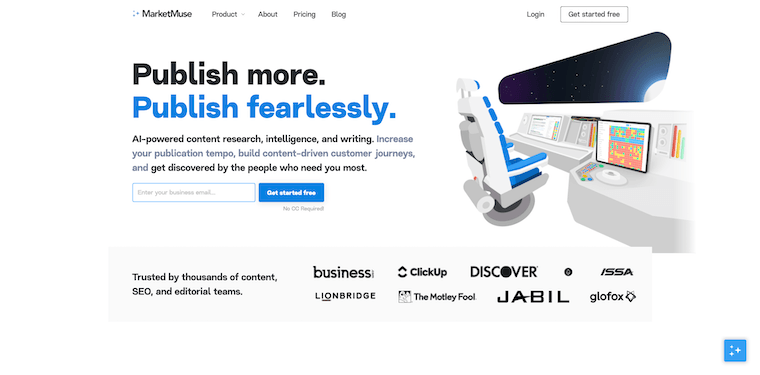
MarketMuse is an AI-powered content research, intelligence, and writing platform that covers all aspects of the content lifecycle. Our patented AI collects and analyzes your content, prioritizes your best opportunities based on Authority and ROI, and builds industry-leading topic models so you can always write the best content on any topic.
We analyze thousands of pages when building out topic models. Only after that do we compare it to the top 20 in the SERP. This approach provides a unique opportunity to differentiate your content from the competition.
MarketMuse’s automated content inventory and audit solution measures content quality and authority across your domain. Research, organize, and prioritize your best content ideas faster than ever.
AI-generated content briefs give you everything you need to write like an expert. Use related topics, get measured with Content Score in our real-time text editor, and act on internal and external linking recommendations.
MarketMuse content editor provides real-time feedback on how well your content matches our topic model. Industry-leading topic models that show you how to write like an expert, providing competitive data on the top search competitors for your topic.
Connect finds internal linking opportunities to build clusters around topics. Get external linking recommendations so you can link to non-competitive but authoritative sources.
Let’s look at some enterprise SEO platforms that offer content optimization to varying extents.
BrightEdge Content IQ
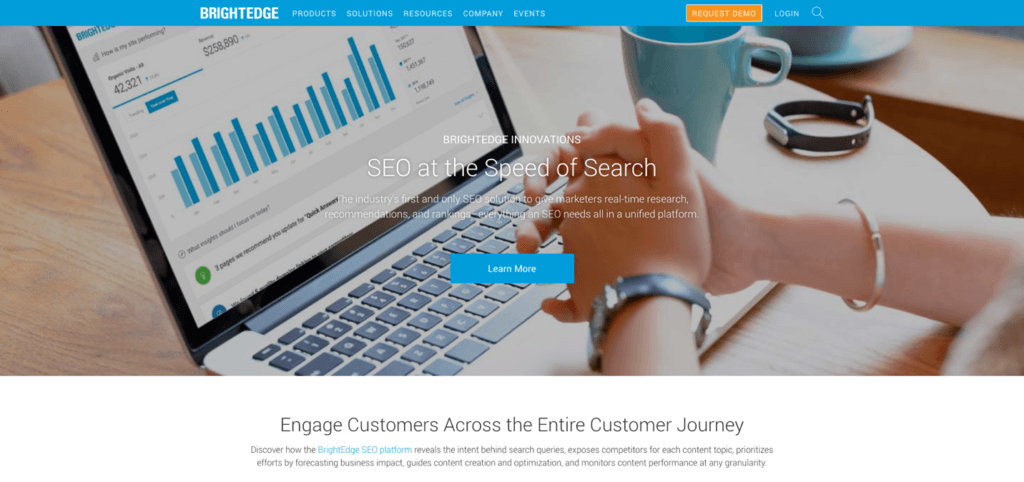
Popular among enterprise SEOs, BrightEdge’s features are dedicated to search engine optimization. Not so when it comes to content. BrightEdge employs no semantic similarity technology, and its content recommendations are basic on-page optimization suggestions.
It has a suite of products including Content IQ. But don’t let the name fool you. It doesn’t help with optimizing your content. Rather, this product provides “full-scale SEO audits for improved site performance.” Which means it’s great for identifying site errors. While BrightEdge does have its uses, content optimization isn’t one of them.
Conductor
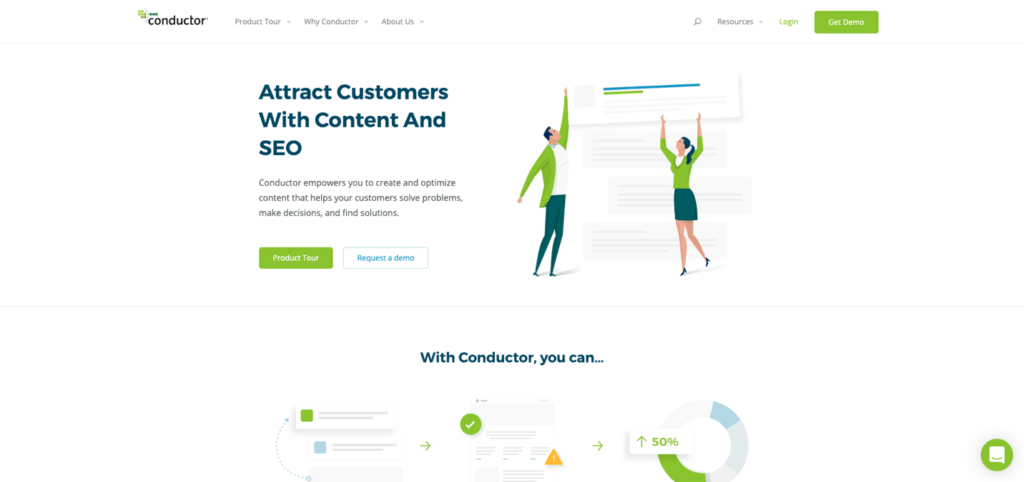
An SEO tool that’s great for rank tracking but not so much for content optimization. Conductor’s competitor analysis does not measure the quality of content with a content score and doesn’t show prioritized next steps.
Conductor’s keyword-based architecture is a compliment for MarketMuse’s relevance-based recommendations. Conductor users frequently look to MarketMuse to solve both page and site-level challenges that require more detail than is possible from data aggregation of keyword rankings and analytics feeds.
Searchmetrics Content Experience

Searchmetrics Content Experience is part of a suite of tools including Research Cloud, Search Experience, and Site Experience. Similar to other Enterprise SEO dashboards, SearchMetrics can track pages and keyword rankings, which can be used alongside manual processes to build content strategies. As well, they provide the ability to create some basic content briefs.
SEOClarity

SEOClarity is primarily known an enterprise SEO platform. Although they do offer a number of tools to help content marketers, such as Content Fusion, which looks like they’ve rebranded as their AI Content Writer.
Like other SEO platforms, you can track your rankings and conduct keyword research including competitive analysis. Their topic research groups keywords with similar intents together but lacks topic modeling like that of other content optimization tools.
However, topic modeling is available within their AI content writer. Note that their AI content writer doesn’t write content. Rather, it functions like a typical content optimizer.
Now, we’ll look at some tools whose primary purpose is to optimize content. While some provide limited ability to create content briefs or outlines, they lack solid content strategy capabilities. You’ll need additional software to help determine your best content opportunities.
Frase
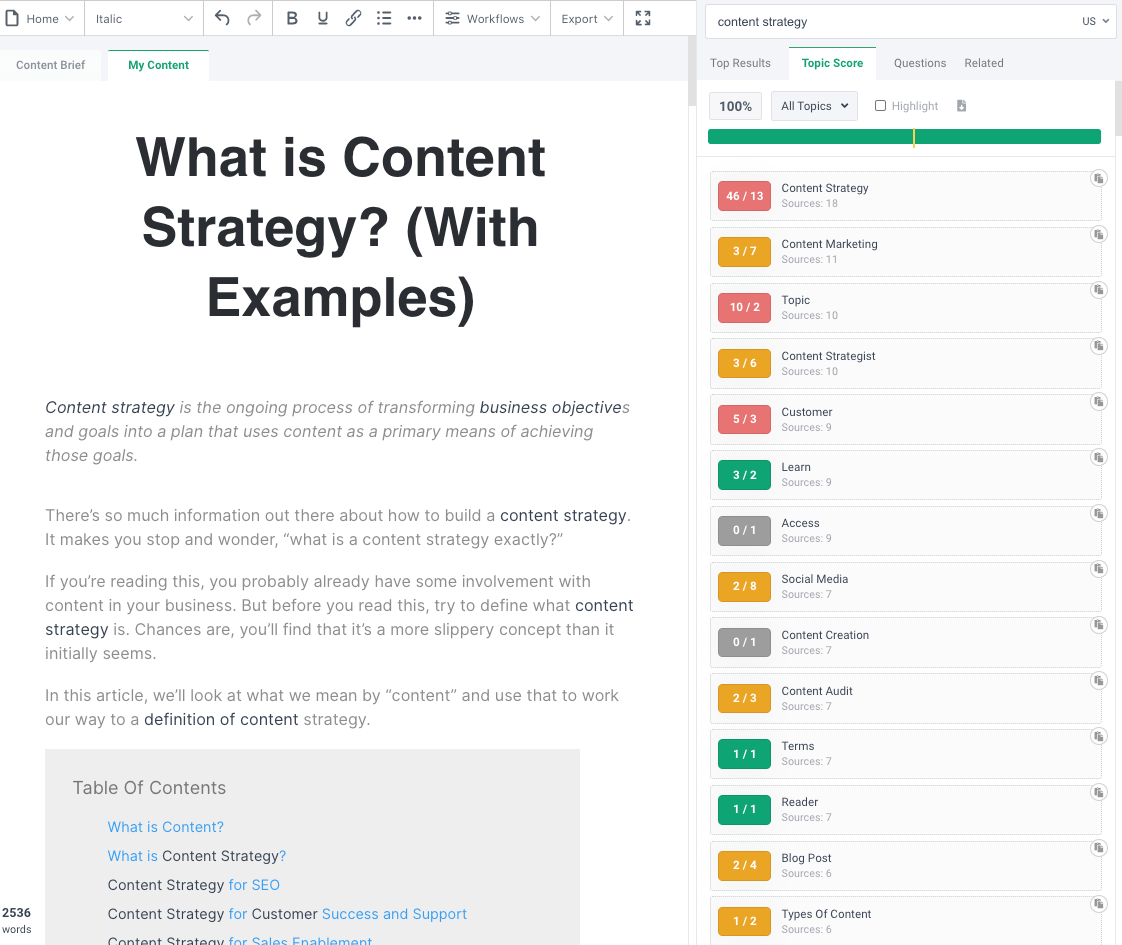
Frase is a content optimization tool that helps content marketers with researching and creating content. Like other content optimizers, it relies on a very small collection of documents to create its topic models. As a result, their suggestions make it difficult to differentiate your content from the competition.
Frase offers custom brief templates which can be helpful if you have a variety of article types which you produce. These briefs typically contain an overwhelming amount of data, which some writers may find distracting. So, you’ll need to edit these briefs into something more concise.
If you’re a Google Search Console fan, you’ll appreciate its integration with Frase. You can avoid building out complicated reports as Frase takes care of that for you.
Clearscope

Clearscope relies on an API to obtain third-party data from IBM Watson. While the topic modeling is better than most other MarketMuse alternatives, it relies on a very small set of documents (the top 30 in Google) to construct its models.
It’s always a challenge to base your product around an API. You’re governed by those rules of access, you pay each time you access that data, and there’s little you can do to expand your offering.
However, Clearscope does offer some basic keyword research capabilities, and they do have a Google Docs add-on and WordPress Plugin.
Next, let’s examine some content optimization tools that are offered as part of a bigger platform.
SEOScout

SEOScout’s editor relies on data provided by IBM Watson, just like Cleascope. As such, it faces the same challenges. The primary difference is that they have a more extensive suite of tools that allow for SEO split testing, keyword research, rank tracking, and SEO performance tracking.
CognitiveSEO

Cognitive SEO is an SEO platform that offers keyword research, rank tracking, content optimization, and more. Its Content Optimizer module contains a keyword explorer and ranking analysis, both with very limited data.
The Content Assistant is a very basic content editor. You have a list of topics but no suggestion as to topic usage. It’s also difficult to discern the recommended depth for any topic and whether that’s been achieved.
SEMRush SEO Writing Assistant

SEMRush SEO Writing Assistant is only available on their upper tier plans. It offers content optimization suggestions based on the top 10 in Google. This is definitely the smallest corpus I’ve seen in any content optimization tool. Most typically use the top 20 or 30 results in Google, although MarketMuse analyzes thousands of documents to create its topic models.
Although limited, it does offer some insight into tone of voice, which is a nice touch. In addition, there’s a Google Docs Add-on and WordPress plugin.
Last, let’s look at some tools that rely on TF-IDF and/or LSI terms for their optimization recommendations.
TF-IDF and LSI Tools
Tools that fall into this category include PageOptimizer Pro, Ryte, Similar Content, and SurferSEO. There’s really nothing to talk about here. As mentioned above, using term frequency inverse document frequency isn’t topic modeling. LSI keywords don’t exist and latent semantic analysis has severe limitations as it was developed way before the Internet.
For a content marketer on a budget, the big attraction to this type of tool is its price. But now you can start generating better revenue with your content for no cost with the free version of MarketMuse.
Additional Tools That Support Content Optimization
Here are some additional tools that we use to produce content for the MarketMuse blog. They tackle specific parts of content optimization not addressed by the other solutions listed above.
RankMath
Rankmath is a WordPress SEO plugin that helps with various search engine optimization tasks such has title, permalink, and meta description optimization. In this case, we’re just making sure not to exceed the recommended word/pixel count for these items.

As a rule of thumb, use the most important words and phrases up front. That way, if Google changes the length they use for search display, you’re less likely to be affected. They’ve done this in the past, so be warned!
Writer

We use Writer to ensure consistent voice, tone, and style, not to mention spelling and grammar. This is content optimization at its most basic. Available as a Chrome extension, it can be used in virtually any situation without disrupting the workflow.
Hemingway Editor

Hemingway Editor helps tighten your copy by highlighting wordy sentences in either yellow or red, depending on their severity. Plus, it highlights adverbs, passive voice, and dull, complicated words to make your writing more powerful and clear.
It’s available online (free) or as a desktop (paid) application for Mac and PC. The desktop version has additional features that can help integrate it into your workflow.
Capitalize My Title

Consistently capitalizing headings is an important detail in improving UX and Capitalize My Title makes it easy. Automatically capitalize and case convert to Title Case (in AP, APA, Chicago, MLA, BB, AMA), sentence case, UPPERCASE, lowercase, and more.
It’s available as a web application (free) or a WordPress plugin (paid subscription). The paid version offers a number of features to integrate with your existing workflow.
Who Needs Content Optimization Tools?
Some software solutions are specifically designed for massive corporations, but we realize there’s a real need for software tailored to mid-size companies and agencies that produce a lot of content but don’t have the budget to support a six-figure solution.
MarketMuse is ideal for companies that have teams of content creators and SEOs who produce multiple pieces per week, and need a scalable solution that produces predictably high-ranking content – without adding another major line item to the budget.
In-House Teams. You may know your business inside and out, but it’s likely there are questions you’re not answering with your content. MarketMuse provides that perspective and much more, including strategic plans, detailed content briefs, and the ability to measure your content against the competition at a granular level. Content optimization software saves your team time and removes the guesswork.
Agencies. Content marketing agencies often struggle to provide expertly written content or tailored insights because they usually have clients across a range of industries. (And you know what they say about Jacks of all trades.) A content optimization solution like MarketMuse lets you provide specific content recommendations and competitive advantages – even if it’s just for a sales call. For your clients, we’ll also produce content briefs that identify questions to answer in your post, inbound and outbound links to include, subheadings, and more.
Freelancers. If you employ freelance content writers, a solution like MarketMuse is irreplaceable. The solution and content brief can bridge the gap between your internal team and their expertise, allowing you to provide detailed, data-based instructions at scale, a process that would otherwise be time-consuming for you or your team. Getting predictable outcomes from a contractor is possible, after all.
What you should do now
When you’re ready… here are 3 ways we can help you publish better content, faster:
- Book time with MarketMuse Schedule a live demo with one of our strategists to see how MarketMuse can help your team reach their content goals.
- If you’d like to learn how to create better content faster, visit our blog. It’s full of resources to help scale content.
- If you know another marketer who’d enjoy reading this page, share it with them via email, LinkedIn, Twitter, or Facebook.
